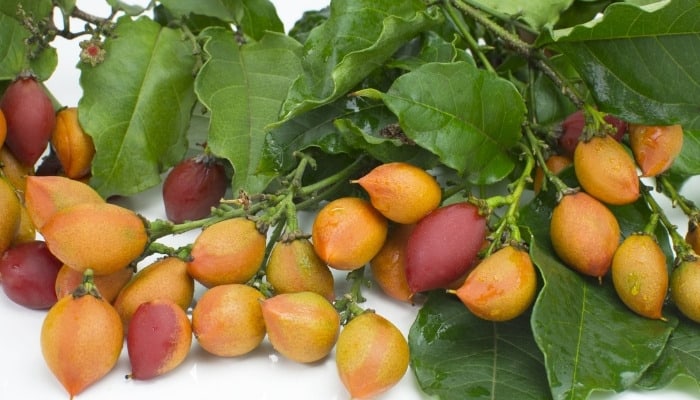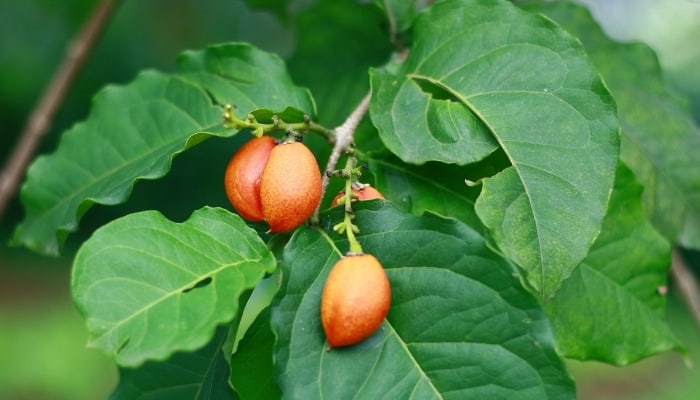Peanut butter is derived from grinding peanuts, which are legumes that grow below ground. You may find it surprising to learn about a tree known as the peanut butter tree.
This fun tree produces fruit that has the smell and flavor of peanut butter!
What is a peanut butter tree? The peanut butter tree is a tropical, self-fertilizing fruit tree that is native to South America. It produces bright yellow flowers and orange-red fruits that are an inch long. The soft fruits taste and smell similarly to peanut butter.
This perennial tree is a whimsical addition to any garden or home.
Even without the pretty flowers or yummy fruit, the peanut butter tree makes an excellent ornamental plant. It grows a broad canopy of bright green leaves that provide welcome shade in the summer.
Peanut Butter Tree Facts
The most interesting fact about the peanut butter tree is that it grows fruit that smells and tastes like peanut butter. Many people don’t know much about this plant or that it even exists!
We will go over everything you need to know about the peanut butter tree to ensure your success.
Peanut Butter Tree at a Glance
The peanut butter tree is a semi-deciduous fruit tree that thrives in tropical environments. Once or twice a year, it produces yellow flowers that develop into the peanut butter-flavored fruits.
Peanut Butter Fruit Tree Appearance
The peanut butter tree can grow to be over 20 feet tall, but most trees average 10-15 feet tall. Their size correlates with proper care and the environment.
During the spring and summer, the trees produce small, bright yellow flowers. If fertilized, the flowers produce green fruits about the size of an olive.
As the fruits ripen, they transition from green to orange to red.
The leaves of the peanut butter tree are broad and pointed. These trees can produce canopies as wide as they are tall.
Peanut Butter Tree Grow Zones
Because peanut butter trees have little to no cold tolerance, they can only be grown outside in zones 10-11. In zones 4-9, you can house these plants indoors year round or during the winter.
Peanut Butter Tree Height
When kept in a pot, the peanut butter tree will not grow as large as those grown in the ground.
In ideal conditions (full sun and a warm climate), the peanut butter tree can grow to be over 20 feet tall with a canopy almost as wide. The average height of peanut butter trees is 10-15 feet tall.
Peanut Butter Tree Growing Conditions
Peanut butter trees are tropical plants that thrive in warm, humid environments. They do best with full sun, but they can also survive in partial sun. It is best to maintain evenly moist soil.
Peanut Butter Tree Growth Rate
These plants have a moderate growth rate. Potted peanut butter trees that are housed inside tend to grow slower than their outdoor counterparts.
Trees grown in zones 10-11 see the fastest growth rate. Gardeners have found that the growth rate is distinctly slower in peanut butter trees that do not receive any fertilizer throughout the year.
Peanut Butter Tree Fruit
Peanut butter trees will produce two fruits per stem. The fruits are about an inch in size and start off green. As they ripen, the fruits change to orange and then red.
While the smell and flavor are similar to peanut butter, the texture of the fruit is similar to a fig.
Peanut butter fruit is distantly related to acerola cherries. Like this “superfood,” peanut butter fruit is high in antioxidants and fiber.
Birds love to enjoy peanut butter fruits right off the tree. To prevent them from eating your harvest, pick the fruits while they are still orange, and leave them on a kitchen counter to ripen.
Alternatively, place bird netting (find it here) over the tree to protect the fruits.
Pests and Diseases
Birds are the most destructive pests that eat ripe fruits.
For the tree as a whole, aphids can be a problem. They typically congregate and cause the most damage around new leaves, flowers, and young fruits.
Fungal infections can be a problem for peanut butter trees because they live in humid and moist environments.
You can help prevent fungal growth by keeping your tree in an area with good airflow and not overwatering the plant.
Peanut Butter Tree Pruning
You only need to prune your tree for aesthetic reasons. With potted trees, regular pruning can help keep the tree to a manageable size. Outdoor trees can also be pruned to make it easier to harvest the fruit.
Peanut Butter Tree Propagation
The most common method of propagation is through seeds, although it is possible to use stem cuttings. The seeds have a high germination rate.
Seeds from fallen fruit can be seen sprouting within a week of hitting the ground. It usually takes 2-3 weeks for the seeds to germinate in a cultivation setting.
Peanut Butter Tree Benefits
For peanut butter lovers, the greatest benefit of the tree is the aroma and flavor of the fruits. Everyone can enjoy the high amounts of antioxidants and fiber in the fruits.
Are Peanut Butter Trees Invasive?
Peanut butter trees are not considered invasive. Even in the Grow Zones where they thrive (10-11), their reproduction and growth are manageable.
They do not pose a threat to native foliage or wildlife.
How Long Does a Peanut Butter Tree Take To Fruit?
It usually takes 2-3 years before a peanut butter tree is mature enough to fruit. When you first notice pretty yellow flowers on your tree, you’ll know that it is old enough to begin producing fruit.
The first harvest will most likely be smaller than subsequent harvests.

Can You Eat the Fruit of the Peanut Butter Tree?
Yes! Peanut butter fruits are best when eaten right off the tree. You can enjoy the yummy peanut butter flavor for even longer by using the fruit to make jam or jelly.
What Does the Fruit of the Peanut Butter Tree Taste Like?
There is some debate about exactly how much peanut butter tree fruit tastes like peanut butter. Some think it is an exact match. Others think the flavor is similar but not precise.
Many people also think there is a fruity flavor along with the peanut butter, reminding them of peanut butter and jelly.
What Are the Uses of Peanut Butter Fruit?
Peanut butter fruit is most commonly eaten fresh. It can also be used to make jams, jellies, and preserves.
What Is a Clerodendrum Peanut Butter Tree?
Clerodendrum trichotomum is also called the peanut butter tree or the harlequin glorybower.
This invasive shrub is native to Asia and has small white or pink flowers. This plant is not related to Bunchosia argentea.
Can Peanut Butter Fruit Trees Grow in Pots?
Yes, the peanut butter tree can grow in a pot and produce fruits. This is the most common growing method for most Grow Zones since the plant can be moved indoors during the colder months.
The tree will not reach maximum size in a pot, but it can still produce delicious fruit when its ideal growing conditions are met.
Can Peanut Butter Tree Grow Indoors?
You can grow a peanut butter tree indoors, but it will not grow as large as outside. This tropical plant loves sunlight, so keep it near the sunniest window in your home.
Do your best to maintain warm temperatures and moderate humidity. Grow lights can be helpful if you are trying to get your tree to produce more fruit.
Grow lights that hang from the ceiling, like this one, are recommended so that the height can be adjusted as the tree grows.
Peanut Butter Tree Care
When planting your peanut butter tree outdoors, dig a hole two times the width of the root ball. Place your tree in the ground, and fill in the remaining area with soil. Water thoroughly.
If you are planting your tree in a pot, choose a pot that is two times the width of the root ball and has plenty of drainage holes.
Your peanut butter tree needs at least 4 hours of sunlight per day, but it will do better with 8 or more hours. Keep the soil evenly moist.
For indoor plants, water when the top 2 inches of soil are dry. Apply a balanced, slow-release fertilizer three times per year during the growing season.
Conclusion
Now that you’ve learned about the peanut butter tree, you are all set for success. This fun and interesting plant adds joy to a garden or home.
Plus, you can feast on the peanut butter fruits as often as you like and amaze your friends and family with a unique fruit!

